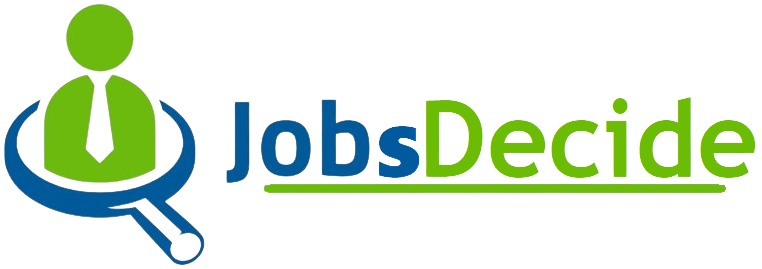What is Object-Orientation?
It is a technique in which we visualize our programming problems in the form of objects and their interactions as happens in real life.
Examples: We have different objects around us in our real life that interact with each other to perform different operations for example, Why OOP?
Similarly, a car is assembled from parts and components, such as chassis, doors, engine, wheels, brake, and transmission. The components are reusable, e.g., a wheel can be used in many cars (of the same specifications).
Hardware, such as computers and cars, are assembled from parts, which are reusable components.
How about software? Can you "assemble" a software application by picking a routine here, a routine there, and expect the program to run? The answer is obviously no! Unlike hardware, it is very difficult to "assemble" an application from software components. Since the advent of computer 60 years ago, we have written tons and tons of programs. However, for each new application, we have to re-invent the wheels and write the program from scratch.
Why re-invent the wheels?
1.1 Traditional Procedural-Oriented languages
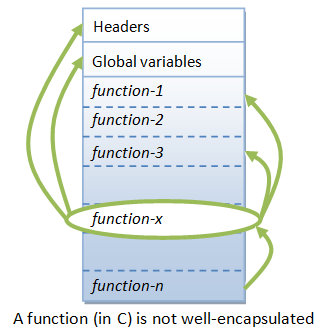
Can we do this in traditional procedural-oriented programming language such as C, Fortran, Cobol, or Pascal?
Traditional procedural-oriented languages (such as C and Pascal) suffer some notable drawbacks in creating reusable software components:
In brief, the traditional procedural-languages separate the data structures and algorithms of the software entities.
In the early 1970s, the US Department of Defense (DoD) commissioned a task force to investigate why its IT budget always went out of control; but without much to show for. The findings are:
- 80% of the budget went to the software (while the remaining 20% to the hardware).
- More than 80% of the software budget went to maintenance (only the remaining 20% for new software development).
- Hardware components could be applied to various products, and their integrity normally did not affect other products. (Hardware can share and reuse! Hardware faults are isolated!)
- Software procedures were often non-sharable and not reusable. Software faults could affect other programs running in computers.
The task force proposed to make software behave like hardware OBJECT. Subsequently, DoD replaces over 450 computer languages, which were then used to build DoD systems, with an object-oriented language called Ada.
1.2 Object-Oriented Programming Languages
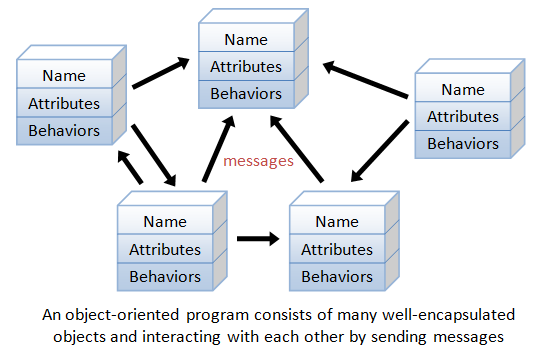
Object-oriented programming (OOP) languages are designed to overcome these problems.
- The basic unit of OOP is a class, which encapsulates both the static attributes and dynamic behaviors within a "box", and specifies the public interface for using these boxes. Since the class is well-encapsulated (compared with the function), it is easier to reuse these classes. In other words, OOP combines the data structures and algorithms of a software entity inside the same box.
- OOP languages permit higher level of abstraction for solving real-life problems. The traditional procedural language (such as C and Pascal) forces you to think in terms of the structure of the computer (e.g. memory bits and bytes, array, decision, loop) rather than thinking in terms of the problem you are trying to solve. The OOP languages (such as Java, C++, C#) let you think in the problem space, and use software objects to represent and abstract entities of the problem space to solve the problem.
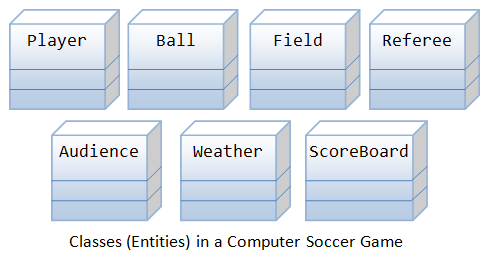
As an example, suppose you wish to write a computer soccer games (which I consider as a complex application). It is quite difficult to model the game in procedural-oriented languages. But using OOP languages, you can easily model the program accordingly to the "real things" appear in the soccer games.
- Player: attributes include name, number, location in the field, and etc; operations include run, jump, kick-the-ball, and etc.
- Ball:
- Reference:
- Field:
- Audience:
- Weather:
Most importantly, some of these classes (such as
Ball and Audience) can be reused in another application, e.g., computer basketball game, with little or no modification.1.3 Benefits of OOP
The procedural-oriented languages focus on procedures, with function as the basic unit. You need to first figure out all the functions and then think about how to represent data.
The object-oriented languages focus on components that the user perceives, with objects as the basic unit. You figure out all the objects by putting all the data and operations that describe the user's interaction with the data.
Object-Oriented technology has many benefits:
- Ease in software design as you could think in the problem space rather than the machine's bits and bytes. You are dealing with high-level concepts and abstractions. Ease in design leads to more productive software development.
- Ease in software maintenance: object-oriented software are easier to understand, therefore easier to test, debug, and maintain.
- Reusable software: you don't need to keep re-inventing the wheels and re-write the same functions for different situations. The fastest and safest way of developing a new application is to reuse existing codes - fully tested and proven codes.
 2. OOP Basics
2. OOP Basics
2.1 Classes & Instances
Class: A class is a definition of objects of the same kind. In other words, a class is a blueprint, template, or prototype that defines and describes the static attributes and dynamic behaviors common to all objects of the same kind.
Instance: An instance is a realization of a particular item of a class. In other words, an instance is an instantiation of a class. All the instances of a class have similar properties, as described in the class definition. For example, you can define a class called "
Student" and create three instances of the class "Student" for "Peter", "Paul" and "Pauline".The term "object" usually refers to instance. But it is often used quite loosely, which may refer to a class or an instance.
2.2 A Class is a 3-Compartment Box encapsulating Data and Functions
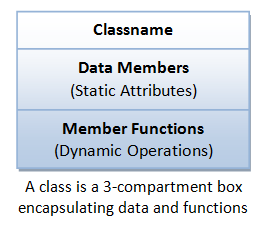
A class can be visualized as a three-compartment box, as illustrated:
In other words, a class encapsulates the static attributes (data) and dynamic behaviors (operations that operate on the data) in a box.
Class Members: The data members and member functions are collectively called class members.
The followings figure shows a few examples of classes:
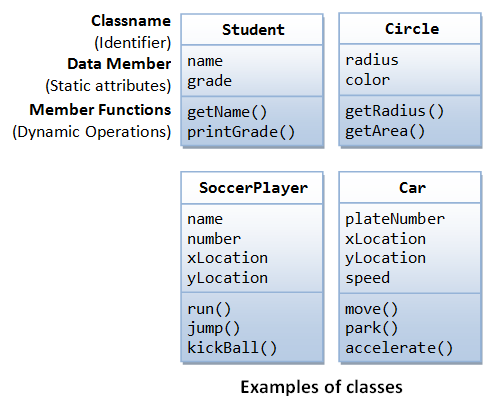
The following figure shows two instances of the class
Student, identified as "paul" and "peter".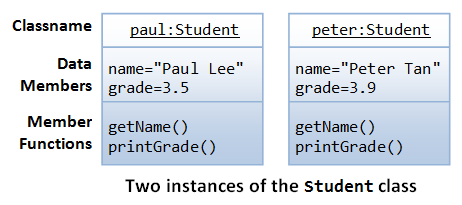
Unified Modeling Language (UML) Class and Instance Diagrams: The above class diagrams are drawn according to the UML notations. A class is represented as a 3-compartment box, containing name, data members (variables), and member functions, respectively. classname is shown in bold and centralized. An instance (object) is also represented as a 3-compartment box, with instance name shown as
instanceName:Classname and underlined. Brief Summary
Brief Summary
- A class is a programmer-defined, abstract, self-contained, reusable software entity that mimics a real-world thing.
- A class is a 3-compartment box containing the name, data members (variables) and the member functions.
- A class encapsulates the data structures (in data members) and algorithms (member functions). The values of the data members constitute its state. The member functions constitute its behaviors.
- An instance is an instantiation (or realization) of a particular item of a class.







